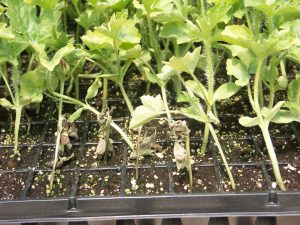Fusarium wilt is one of the most serious diseases of watermelon in the Midwest. The disease often causes a one-sided wilt 2-3 weeks after transplanting. Whether a plant is affected, and to what degree, depends on the population of the long-lived spores in the soil that the roots contact. However, Fusarium wilt of watermelon is not known to spread from plant to plant in the field. This is in contrast with a disease such as anthracnose which can spread from plant-to-plant rapidly in one season.
Occasionally, Fusarium wilt can be observed affecting commercially produced watermelon transplants in new trays and virgin soilless mix. The most likely explanation for such outbreaks is the introduction of Fusarium wilt on seed. The distribution of Fusarium wilt from seed should appear random. However, we often observe a clustered distribution of affected seedlings as seen in Figure 1. We conducted an investigation to determine whether the distribution of Fusarium wilt in transplant trays could be shown to be statistically clustered. Our hypothesis was that the diseased transplants were in a clustered distribution, not random. Seedlings in a clustered distribution would suggest that Fusarium wilt spread from plant to plant within the transplant trays.

Figure 1. We often observe Fusarium wilt in transplant trays in a clustered distribution. We believe that Fusarium wilt may spread from plant-to-plant within a transplant tray, perhaps by soil splash or spores that have been observed on diseased seedlings.
To conduct the statistical tests, I teamed up with Judy Santini of Purdue University. We assessed disease for each watermelon transplant in 19 trays from a 2006 outbreak and 10 trays in 2016. We compared statistically the actual distribution of diseased plants to a random distribution of the same number of cells. We used a one-tailed T-test to compare the hypothesis that the mean distances for diseased plants is < the mean distance for random cells. Test repeated 10 times for each transplant tray.
2006 outbreak – In 12 out of 19 trays, the mean distance of diseased plants was statistically less than the mean of all 10 random samples.
2016 outbreak – In 3 trays out of 10, the mean distance of diseased plants was statistically less than the mean of at least 9 random samples.
Our results indicate that in at least some of the transplant trays the distribution of Fusarium wilt is clustered, not random. We believe that the most likely explanation of the clustered distribution of diseased plants in the transplant trays is the seed transmission of Fusarium wilt and subsequent plant-to-plant spread. We believe this is the first report to suggest the secondary spread of Fusarium wilt of watermelon. These conclusions apply only to Fusarium wilt in the greenhouse/transplant tray.
Recommendations to manage Fusarium wilt of Fusarium wilt include:
- Use new soil and trays or sanitize trays that are being reused.
- Purchase watermelon seed tested for Fusarium wilt.
- Scout for symptoms of Fusarium wilt of watermelon or inspect seedlings carefully upon delivery.
- Obtain an official diagnosis of possible diseased plants.
- Since this study suggests that Fusarium wilt may spread in transplant trays, don’t attempt to plant healthy seedlings from trays where Fusarium wilt has been observed.
Fusarium wilt can be a serious disease of watermelon. Avoid planting seedlings that may have this disease.